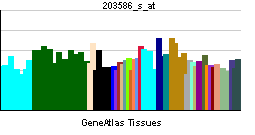ARL4D
| ADP-ribosylation factor-like 4D | |||||||||||
|---|---|---|---|---|---|---|---|---|---|---|---|
| Identifiers | |||||||||||
| Symbols | ARL4D ; ARF4L; ARL6 | ||||||||||
| External IDs | Template:OMIM5 Template:MGI HomoloGene: 1255 | ||||||||||
| |||||||||||
| RNA expression pattern | |||||||||||
 | |||||||||||
| More reference expression data | |||||||||||
| Orthologs | |||||||||||
| Template:GNF Ortholog box | |||||||||||
| Species | Human | Mouse | |||||||||
| Entrez | n/a | n/a | |||||||||
| Ensembl | n/a | n/a | |||||||||
| UniProt | n/a | n/a | |||||||||
| RefSeq (mRNA) | n/a | n/a | |||||||||
| RefSeq (protein) | n/a | n/a | |||||||||
| Location (UCSC) | n/a | n/a | |||||||||
| PubMed search | n/a | n/a | |||||||||
ADP-ribosylation factor-like 4D, also known as ARL4D, is a human gene.[1]
ADP-ribosylation factor 4D is a member of the ADP-ribosylation factor family of GTP-binding proteins. ARL4D is closely similar to ARL4A and ARL4C and each has a nuclear localization signal and an unusually high guanine nucleotide exchange rate. This protein may play a role in membrane-associated intracellular trafficking. Mutations in this gene have been associated with Bardet-Biedl syndrome (BBS).[1]
References
Further reading
- Miki Y, Swensen J, Shattuck-Eidens D; et al. (1994). "A strong candidate for the breast and ovarian cancer susceptibility gene BRCA1". Science. 266 (5182): 66–71. PMID 7545954.
- Harshman K, Bell R, Rosenthal J; et al. (1995). "Comparison of the positional cloning methods used to isolate the BRCA1 gene". Hum. Mol. Genet. 4 (8): 1259–66. PMID 7581362.
- Smith SA, Holik PR, Stevens J; et al. (1995). "Isolation and mapping of a gene encoding a novel human ADP-ribosylation factor on chromosome 17q12-q21". Genomics. 28 (1): 113–5. doi:10.1006/geno.1995.1115. PMID 7590735.
- Bonaldo MF, Lennon G, Soares MB (1997). "Normalization and subtraction: two approaches to facilitate gene discovery". Genome Res. 6 (9): 791–806. PMID 8889548.
- Jacobs S, Schilf C, Fliegert F; et al. (1999). "ADP-ribosylation factor (ARF)-like 4, 6, and 7 represent a subgroup of the ARF family characterization by rapid nucleotide exchange and a nuclear localization signal". FEBS Lett. 456 (3): 384–8. PMID 10462049.
- Ingley E, Williams JH, Walker CE; et al. (1999). "A novel ADP-ribosylation like factor (ARL-6), interacts with the protein-conducting channel SEC61beta subunit". FEBS Lett. 459 (1): 69–74. PMID 10508919.
- Nonaka Y, Tsuda N, Shichijo S; et al. (2003). "Recognition of ADP-ribosylation factor 4-like by HLA-A2-restricted and tumor-reactive cytotoxic T lymphocytes from patients with brain tumors". Tissue Antigens. 60 (4): 319–27. PMID 12472661.
- Strausberg RL, Feingold EA, Grouse LH; et al. (2003). "Generation and initial analysis of more than 15,000 full-length human and mouse cDNA sequences". Proc. Natl. Acad. Sci. U.S.A. 99 (26): 16899–903. doi:10.1073/pnas.242603899. PMID 12477932.
- Chiang AP, Nishimura D, Searby C; et al. (2004). "Comparative genomic analysis identifies an ADP-ribosylation factor-like gene as the cause of Bardet-Biedl syndrome (BBS3)". Am. J. Hum. Genet. 75 (3): 475–84. doi:10.1086/423903. PMID 15258860.
- Fan Y, Esmail MA, Ansley SJ; et al. (2004). "Mutations in a member of the Ras superfamily of small GTP-binding proteins causes Bardet-Biedl syndrome". Nat. Genet. 36 (9): 989–93. doi:10.1038/ng1414. PMID 15314642.
- Gerhard DS, Wagner L, Feingold EA; et al. (2004). "The status, quality, and expansion of the NIH full-length cDNA project: the Mammalian Gene Collection (MGC)". Genome Res. 14 (10B): 2121–7. doi:10.1101/gr.2596504. PMID 15489334.
- Rual JF, Venkatesan K, Hao T; et al. (2005). "Towards a proteome-scale map of the human protein-protein interaction network". Nature. 437 (7062): 1173–8. doi:10.1038/nature04209. PMID 16189514.
- Hofmann I, Thompson A, Sanderson CM, Munro S (2007). "The Arl4 family of small G proteins can recruit the cytohesin Arf6 exchange factors to the plasma membrane". Curr. Biol. 17 (8): 711–6. doi:10.1016/j.cub.2007.03.007. PMID 17398095.
| This protein-related article is a stub. You can help Wikipedia by expanding it. |